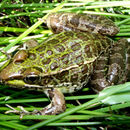Brief Summary
provided by EOL authors
The Chiricahua leopard frog (Lithobates chiricahuensis) is a medium to large, stocky frog with adult lengths snout to vent from 5.0- 13.5 cm (2.0-5.4 in). The ground color on the dorsum is green to brown; the upper lip stripe is faint or absent in front of the eye; the head and face is usually green. The skin is rougher with more tubercles, and dorsal spots are generally smaller and more numerous than in other leopard frogs. Dorsolateral folds are broken toward the rear of the body, angling inward. The eyes are higher on the head and more upturned than other Arizona leopard frogs. The hind feet are webbed, and males have a swollen and darkened thumb base. In adults (and some juveniles), the rear surface of the thigh is speckled with “salt and pepper” markings, or small dots each densely covered with light-tipped tubercles, usually on a dark ground color. (Stebbins 1985; Brennan and Holycross 2006). The venter is a dull whitish or yellowish color, while gray mottling usually occurs on the throat and sometimes on the chest. The groin and lower abdomen are often yellow. Platz (1988) notes that the “posterior surfaces of thighs have numerous small papilla, each surrounded by cream colored skin...adults have mottled venter and males along southern Arizona border have vestigial oviducts.” Found in mountain regions of central and southeastern Arizona, southwestern New Mexico, south in the Sierra Madre Occidental to Western Jalisco, Mexico from 1066-2408 m (3500-7900 ft), (Platz and Mecham 1979; Sredl et al. 1997). They are highly aquatic habitat generalists. Adults become active in February (Jennings 1988, 1990), and eggs are laid in spring and sporadically through the summer and fall. Males usually call above water, but may also advertise below water (Degenhardt et al. 1996). Their call consists of a 1-3 second long, low-pitched, hollow snore (Brennan and Holycross 2006). Home ranges for males (dry season mean = 161.0 m2; wet season mean = 375.7 m2) tend to be larger than those for females (dry season mean = 57.1 m2; wet season mean = 92.2 m2). Post-metamorphic Chiricahua leopard frogs are generally inactive from November-February, however, a detailed study of wintertime activity or habitat use has not been done. Although microsites for these hibernacula have not been studied, they likely over-winter near breeding sites. (Sredl, in Lannoo 2005). Life span and age at first reproduction are unknown, although preliminarily, skeletochronology of Chiricahua leopard frogs indicate that they can live =/

